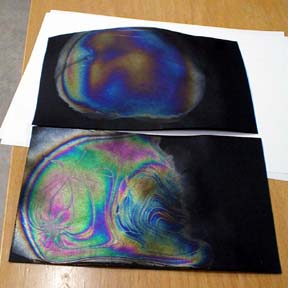Clearly colorful

Clear nail polish on black paper shows interference
colors.
Clearly colorful

Clear nail polish on black paper shows interference
colors.
Introduction
A thin layer of clear nail polish on a black background will create interference colors.
Material
Assembly
Fill the cooking pan with water
To Do and Notice
Put a sheet of black construction paper underwater in the cooking pan.
Use the brush to drip one drop of nail polish onto the center of the water in the cooking pan.
Notice that the drop of nail polish stays together for a second, then spreads into a layer on the surface of the water.
Once the drop has spread, lift the black construction paper out of the water lifting the layer of clear nail polish as a coating on the paper.
Set the paper aside to dry.
Notice the oil slick like colors that appear on the black paper.
What's Going On?
The layer of nail polish spreads until it is very thin, as thin as a wavelength of light.
Light reflects from the top surface of the layer of nail polish and from the bottom surface too.
Light waves reflecting from the top and bottom surfaces will add together.
When the thickness of the nail polish is a half-wavelength of blue light thick, then blue light from the front and back surfaces will be out of phase and will not reflect. At this same thickness red light will be in-phase and will reflect strongly giving the reflected light a reddish color. (Half a wavelength of blue light in the nail polish is about 250 nm.)
When the thickness is a half-wavelength of red light then red will not reflect but blue will giving the reflected light a bluish color.(Half a wavelength of red light in the nail polish is about 450 nm.)
The colors provide a topographic contour map of the thickness of the nail polish film measured in half-wavelengths of light.
See Soap Film Interference Model and Soap Film Color for more details.
I was shown this activity by Linda Shore. It can be found in the book "The Science Explorer" published by the Exploratorium.
|
Scientific Explorations with Paul Doherty |
|
7 June 2000 |